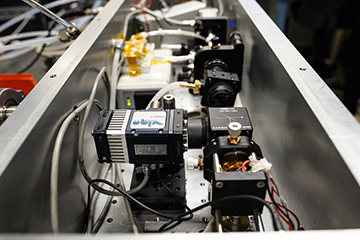
Researchers have developed a new sensor that uses an interband cascade light emitting device (ICLED) and could allow practical and low-cost detection of low concentrations of methane. [Image: Sameer Khan]
Methane ranks as one of the most potent greenhouse gases, with a global warming potential 28 to 36 times greater than carbon dioxide over a hundred-year period. It’s believed to account for about 20% of anthropogenic global warming. And its dominant sources are oil and natural gas systems, agricultural activities and coal mining.
These industries increasingly seek affordable, accurate sensing technologies that can measure methane emissions and leaks. To this end, a U.S. research team has developed a sensitive, low-cost methane sensor that uses an interband cascade light emitting device (ICLED) as a light source (Opt. Express, doi: 10.1364/OE.415724).
Power boost
Currently, high-end optical methane sensors can range from US$10,000 to US$100,000 each, with the advantages of precision, sensitivity and accuracy. Midwave infrared light-emitting diodes (LEDs) were proposed to lower the price point of such devices, but they suffered from low optical power.
Researchers from Princeton University and the U.S. Naval Research Laboratory decided to employ an alternative type of broadband, high-optical-power device to improve the performance of low-cost optical gas sensors. ICLEDs utilize the active core of an interband cascade laser but lack upper and lower optical cladding layers. Their ICLED-based sensor uses a plastic, hollow-core fiber and direct absorption spectroscopy to detect sub-parts-per-million by volume (ppmv) methane concentrations.
“The ICLEDs we developed emit roughly 10 times more power than commercially available mid-IR LEDs had generated, and could potentially be mass-produced,” said study author Jerry Meyer, research physicist at the U.S. Naval Research Laboratory, in a press release accompanying the research. “This could enable ICLED-based sensors that cost less than US$100 per sensor.”
Sub-ppmv sensitivity
Meyer and his colleagues performed controlled concentration measurements with their device inside of a gas calibration chamber. Infrared light from the ICLED was coupled into a hollow-core fiber containing an air sample, and the fiber output was then focused onto a photodetector. Methane concentrations were varied from 0 ppmv to 20 ppmv, changed incrementally every three minutes by 5 ppmv.
The Beer-Lambert law was used to calculate absorbance from the normalized signal. They compared results with a commercial, laser-based trace gas analyzer and observed excellent agreement between the two devices. Overall, the ICLED-based sensor could successfully detect methane concentrations as low as 0.1 parts per million. Allan deviation analysis at a constant concentration of 10 ppmv to estimate stability due to noise processes resulted in a noise equivalent absorption of 0.17 ppmv at 1 Hz.
Feasibility of ICLED-based sensors
The study’s findings demonstrate the feasibility of using ICLEDs and hollow-core fibers to affordably monitor low levels of methane. Although more work is needed to increase sensor performance, the device shows potential for use at prominent methane emission sources such as petrochemical infrastructure, agricultural activities and wastewater treatment plants.
“This level of precision is sufficient to monitor emissions near sources of methane pollution,” said first author Nathan Li, a civil and environmental engineering graduate student at Princeton University. “An array of these sensors could be installed to measure methane emissions at large facilities, allowing operators to affordably and quickly detect leaks and mitigate them.”
